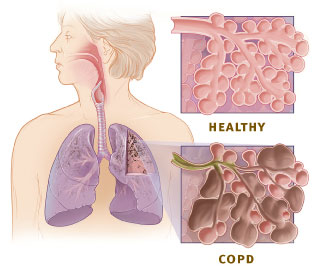What Is COPD?
Chronic obstructive pulmonary disease (COPD) is a
lung disease in which the lungs are damaged, making it hard to breathe. In
COPD, the airways—the tubes that carry air in and out of your
lungs—are partly obstructed, making it difficult to get air in and out.
Cigarette smoking is the most common cause of COPD.
Most people with COPD are smokers or former smokers. Breathing in other kinds
of lung irritants, like pollution, dust, or chemicals, over a long period of
time may also cause or contribute to COPD.
The airways branch out like an upside-down tree, and
at the end of each branch are many small, balloon-like air sacs called alveoli
(al-VEE-uhl-EYE). In healthy people, each airway is clear and open. The air
sacs are small and dainty, and both the airways and air sacs are elastic and
springy. When you breathe in, each air sac fills up with air like a small
balloon; when you breathe out, the balloon deflates and the air goes out. (See
the How the Lungs Work section for
details.) In COPD, the airways and air sacs lose their shape and become floppy.
Less air gets in and less air goes out because:
- The airways and air sacs lose their elasticity
(like an old rubber band).
- The walls between many of the air sacs are
destroyed.
- The walls of the airways become thick and
inflamed (swollen).
- Cells in the airways make more mucus (sputum)
than usual, which tends to clog the airways.
COPD

The illustration show the
respiratory system and cross-sections of healthy alveoli and alveoli with
COPD.
COPD develops slowly, and it may be many years
before you notice symptoms like feeling short of breath. Most of the time, COPD
is diagnosed in middle-aged or older people.
COPD is a major cause of death and illness, and it
is the fourth leading cause of death in the United States and throughout the
world.
There is no cure for COPD. The damage to your
airways and lungs cannot be reversed, but there are things you can do to feel
better and slow the damage.
COPD is not contagious—you cannot catch it from
someone else.
July 2007
|

